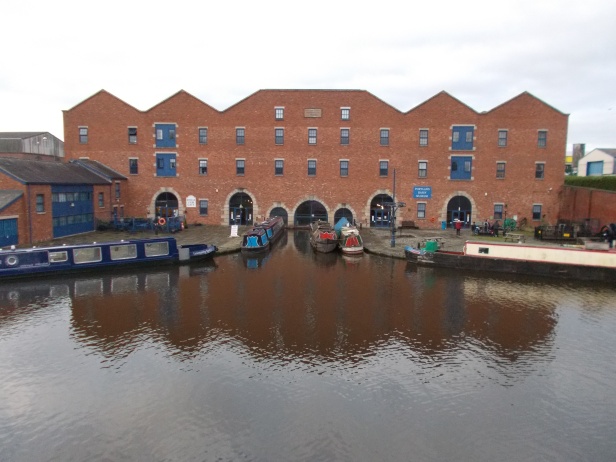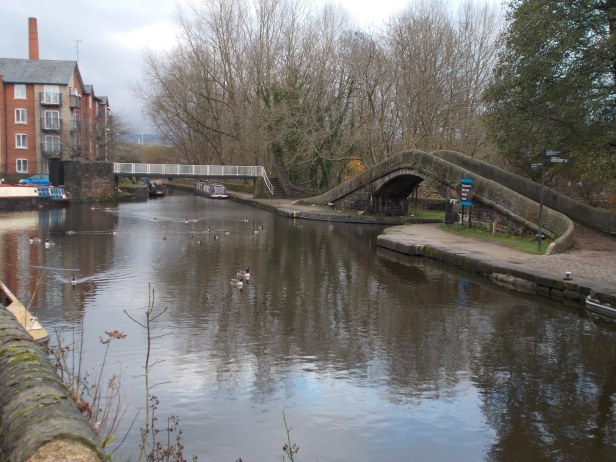Portland Basin Warehouse was one of the largest and most expensive canal storage buildings ever constructed. It was built in 1834 by David Bellhouse & Co for the Ashton Canal Company. It stands at the junction of Ashton Canal and Peak Forest Canal. Visitors today to the museum can marvel not only at the size of the warehouse but also at the three arch aqueduct that holds the canals above the River Tame.

It was a multipurpose warehouse for storing raw cotton from Liverpool and limestone from the Peak District as well as huge amounts of coal and grain. Thousands of tonnes of goods were moved in and out of it each year. It would have been an almost constant hive of activity with multiple loading bays on all four sides of the building.
The south-facing wharf side had the most bays, thirteen in total. (See the picture above to understand the following details). The central feature of the south side is the internal canal arms. These enabled barges to come right into the building to be unloaded. Where most warehouses had only two canal arms, Portland Basin Warehouse had three. The arms were each 25 metres long, with the central one being the widest. There were also two cart entrances in yards on either side of the canal arms. A couple had extra-large loading bay doors above them, complete with their own crane.
The other three sides of the building could also be used for loading and unloading. The north side had ten bays, five of which had large loading doors. The west and east side had five bays, but only a single large loading door.
Security was taken seriously. The wharf side yards were protected by high brick walls with a pair of large cast iron gates either side (still in place today). The ground floor windows on the north, east and west side all had iron bars on.
The interior of the building consisted of three timber floors supported by cast iron columns. Some of the columns had hoists fitted to them, and parts of these survive and are on show in the museum. The internal canal arms had trap doors in the floors above.
The Cutting Edge Waterwheel

The original hand-operated cranes that were used for loading were found to be inadequate as traffic and goods increased in the first few years of the operation of the building. Between 1839 and 1841, a breast shot waterwheel was built that could drive power to a new hoist system. It was three feet wide and twenty four feet in diameter. The force was transmitted by a 416-tooth rim gear on the outer surface of the wheel onto a series of gears that could transfer it into the warehouse. The power it sent into the warehouse could be controlled independently on each floor. It had its own brick wheelhouse and was fed from a leat running under the basin from Ashton Canal to the wheel pit. Once used, the water was discharged into the river Tame.
The end and a new beginning
As the 20th century progressed the canal network started to go into decline. In 1905, the Ashton Canal carried almost 250,000 tons of coal, by 1931 this had dropped to around 23,000 and by 1947, a mere 5,400 tons. By the 1960s, all commercial canal traffic had stopped.
In 1972, Portland Basin Warehouse was devastated by fire that had started in a storage area that held paints and solvents. The damage was so bad that the top two storeys had to be demolished. However, things took a brighter turn in the 1980s as Tameside Council adopted the building and began a two-part restoration. In 1985, a small heritage centre and museum were established and three years later the waterwheel was restored by Dorothea Restorations of Whaley Bridge, Derbyshire. The second part occurred in 1997 when the warehouse was rebuilt to its original height at a cost of £8 million. Two years later, a much enlarged museum opened on the first and second storeys, the third storey housing conference facilities, offices and flats.

As well as displays about the history of Portland Basin, the museum also has lots of information on the social history of Tameside. Displays range from the earliest time periods through to the Medieval and beyond. There is even a reconstructed life size 1920s street. The shop sells a large range of excellent history books on Tameside, many written by Dr. Mike Nevell of University of Salford.
Site visited by A. and S. Bowden 2018
Access
Portland Basin Museum is open Tuesdays through to Sundays 10-4pm. Closed on Mondays except for bank holidays.
Entry is free and there is also free parking on site. Click the link below for their website.
https://www.tameside.gov.uk/portlandbasin
References
Portland Basin and the archaeology of the canal warehouse: Volume 1 In the Archaeology of Tameside Series (2001) Michael Nevell and John Walker, Tameside MBC
Portland Basin Museum website